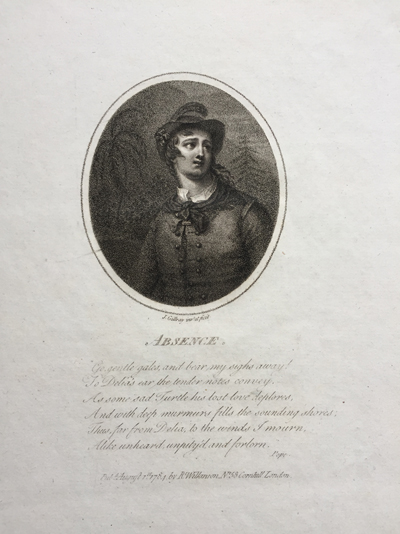Absence
This is one of two paired prints both published on the same day (August 1st, 1784) by the same publisher Robert Wilkinson. The other is Remembrance. They feature single figure portrait busts: one male and one female, each in rustic garb, mourning for what they believe is their lost love. As in most pastoral art, there is an implied congruity between man and nature. In Absence, the "gentle gales" reflect and bear the sighs of this lover. In Remembrance, Each flow'ry Bed, each thicket, & each grove/ Brings to my mind my lost Philander's love. The two prints were almost certainly designed to hang on the same wall like matching husband and wife paintings gazing mournfully at one another.

© Benjamin Lemer, Private Collection
With some small changes, the lines below the image are from Alexander Pope's Autumn: The Third Pastoral, or Hylas and Aegon. In early versions of Pope's poem, the absent lover was Strephon in keeping with Pope's Greek models. But later versions changed it to Delia, and Gillray follows those, especially since the lamenting figure in his print is male.
Go gentle gales, and bear my sighs away!
To Delia's ear the tender notes convey.
As some sad Turtle his lost love deplores,
And with deep murmurs fills the sounding shores;
Thus, far from Delia, to the winds I mourn,
Alike unheard, unpity'd, and forlorn.
These sentimental pastoral prints do not suit modern tastes, especially coming from someone like Gillray who is best known as a satirist. But from May 1783 until the end of 1784, most of Gillray's work was well within the what we would now call the pastoral tradition, including other paired prints such as Innocence and Remorse in May of 1783, Conquest and Disappointment in July 1783, Nutting and Sheep Sheering in August, 1783, and most ambitiously, the large and complex paired prints The Village Train and The Deserted Village in June of 1784. Both of the last two are illustrations of lines taken from arguably the most popular pastoral poem of the 18th century—Oliver Goldsmith's The Deserted Village (1770).
Especially in 1784 Gillray was making a concerted attempt to establish himself as one of the elite etcher/engravers who could make a very good living creating prints from well-known paintings. So he may have chosen pastoral subjects to begin with because they would have been immediately popular. But he may have been drawn to the subject for personal reasons as well. For his work as a professional artist and satirist, Gillray would have been making regular trips from the relatively country-like Chelsea where he lived with his parents next to the churchyard into the very heart of bustling London where the print shops were located. The contrast would have been striking. And he certainly would have seen first hand the gradual encroachment of London city life into the surrounding country. Like Goldsmith, he might have felt that there was much to lament.
Sources and Reading
- "Robert Wilkinson (cartographer)," Wikipedia
- "III. Autumn: or Hylas and Aegon," Eighteenth Century Collections Online
- "Pastoral," Wikipedia
- "James Gillray: Made in Chelsea," The Printshop Window
NOTE: Comments and/or corrections are always appreciated. You can always send a comment, correction, suggestion, or addition using the Comment & Corrections Form below.
Comments & Corrections
NOTE: Comments and/or corrections are always appreciated. To make that easier, I have included a form below that you can use. I promise never to share any of the info provided without your express permission.